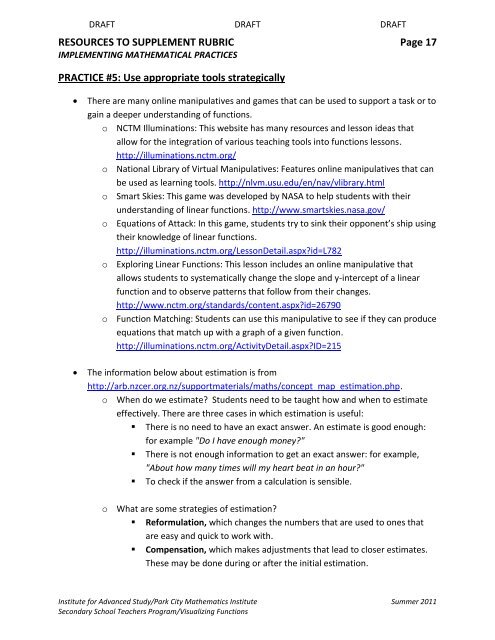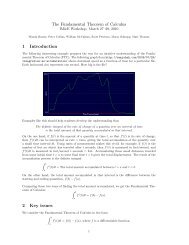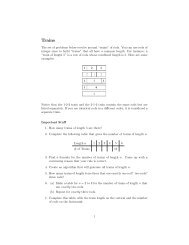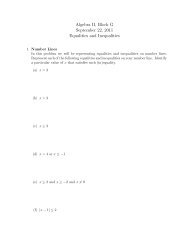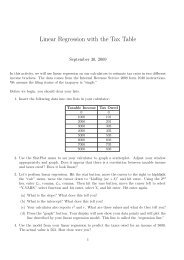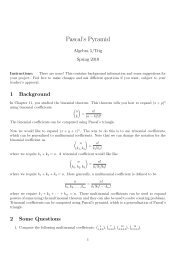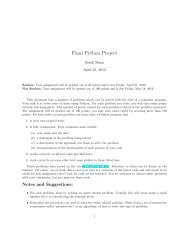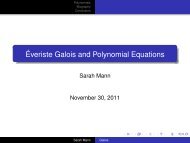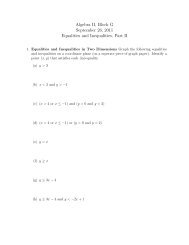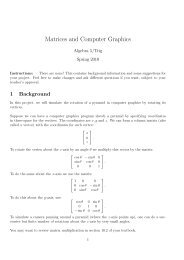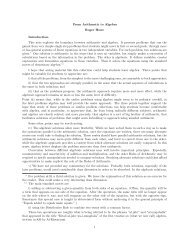Resources to supplement this rubric - Institute for Mathematics ...
Resources to supplement this rubric - Institute for Mathematics ...
Resources to supplement this rubric - Institute for Mathematics ...
Create successful ePaper yourself
Turn your PDF publications into a flip-book with our unique Google optimized e-Paper software.
DRAFT DRAFT DRAFT<br />
RESOURCES TO SUPPLEMENT RUBRIC Page 17<br />
IMPLEMENTING MATHEMATICAL PRACTICES<br />
PRACTICE #5: Use appropriate <strong>to</strong>ols strategically<br />
There are many online manipulatives and games that can be used <strong>to</strong> support a task or <strong>to</strong><br />
gain a deeper understanding of functions.<br />
o NCTM Illuminations: This website has many resources and lesson ideas that<br />
allow <strong>for</strong> the integration of various teaching <strong>to</strong>ols in<strong>to</strong> functions lessons.<br />
http://illuminations.nctm.org/<br />
o National Library of Virtual Manipulatives: Features online manipulatives that can<br />
be used as learning <strong>to</strong>ols. http://nlvm.usu.edu/en/nav/vlibrary.html<br />
o Smart Skies: This game was developed by NASA <strong>to</strong> help students with their<br />
understanding of linear functions. http://www.smartskies.nasa.gov/<br />
o Equations of Attack: In <strong>this</strong> game, students try <strong>to</strong> sink their opponent’s ship using<br />
their knowledge of linear functions.<br />
http://illuminations.nctm.org/LessonDetail.aspx?id=L782<br />
o Exploring Linear Functions: This lesson includes an online manipulative that<br />
allows students <strong>to</strong> systematically change the slope and y-intercept of a linear<br />
function and <strong>to</strong> observe patterns that follow from their changes.<br />
http://www.nctm.org/standards/content.aspx?id=26790<br />
o Function Matching: Students can use <strong>this</strong> manipulative <strong>to</strong> see if they can produce<br />
equations that match up with a graph of a given function.<br />
http://illuminations.nctm.org/ActivityDetail.aspx?ID=215<br />
The in<strong>for</strong>mation below about estimation is from<br />
http://arb.nzcer.org.nz/supportmaterials/maths/concept_map_estimation.php.<br />
o When do we estimate? Students need <strong>to</strong> be taught how and when <strong>to</strong> estimate<br />
effectively. There are three cases in which estimation is useful:<br />
There is no need <strong>to</strong> have an exact answer. An estimate is good enough:<br />
<strong>for</strong> example "Do I have enough money?"<br />
There is not enough in<strong>for</strong>mation <strong>to</strong> get an exact answer: <strong>for</strong> example,<br />
"About how many times will my heart beat in an hour?"<br />
To check if the answer from a calculation is sensible.<br />
o What are some strategies of estimation?<br />
Re<strong>for</strong>mulation, which changes the numbers that are used <strong>to</strong> ones that<br />
are easy and quick <strong>to</strong> work with.<br />
Compensation, which makes adjustments that lead <strong>to</strong> closer estimates.<br />
These may be done during or after the initial estimation.<br />
<strong>Institute</strong> <strong>for</strong> Advanced Study/Park City <strong>Mathematics</strong> <strong>Institute</strong> Summer 2011<br />
Secondary School Teachers Program/Visualizing Functions


